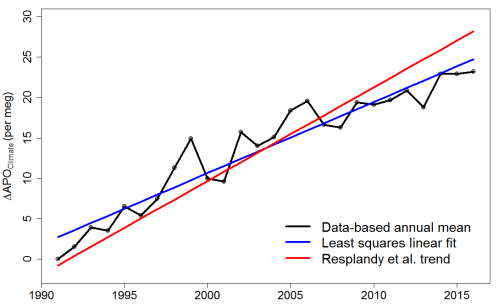The scientists behind a headline-grabbing global warming study did something that seems all too rare these days — they admitted to making mistakes and thanked the researcher, a global warming skeptic, who pointed them out.Their first error was pretty basic. The statistics on a simple linear regression was simply wrong. From Lewis:
“When we were confronted with his insight it became immediately clear there was an issue there,” study co-author Ralph Keeling told The San Diego Union-Tribune on Tuesday.
Their study, published in October, used a new method of measuring ocean heat uptake and found the oceans had absorbed 60 more heat than previously thought. Many news outlets relayed the findings, but independent scientist Nic Lewis quickly found problems with the study.
Keeling, a scientist at the Scripps Institution of Oceanography, owned up to the mistake and thanked Lewis for finding it. Keeling and his co-authors submitted a correction to the journal Nature. (RELATED: Headline-Grabbing Global Warming Study Suffers From A Major Math Error)
“We’re grateful to have it be pointed out quickly so that we could correct it quickly,” Keeling said.
In a statement posted online Friday, Keeling said “the combined effect of these two corrections to have a small impact on our calculations of overall heat uptake.” However, Keeling said the errors mean there are “larger margins of error” than they initially thought.
Figure 1 shows how my 0.88 per meg per year linear fit trend (blue line) and Resplandy et al.’s 1.16 per meg per year trend (red line) compare with the underlying ΔAPOClimate data values.
 |
| Figure 1. ΔAPOClimate data values (black), the least squares linear fit (blue line) to them, and the linear trend per Resplandy et al. (red line) |
Assuming I am right that Resplandy et al. have miscalculated the trend in ΔAPOClimate, and hence the trend in ocean heat content (OHC), implied by their data, the corrected OHC trend estimate for 1991–2016 (Figure 2: lower horizontal red line) is about average compared with the other estimates they showed, and below the average for 1993–2016.They should have been able to see that error from looking at the figure. The data just don't have as much slope as they claim. It makes you wonder who calculated it, and how it was calculated.
The other error is less obvious; they miscalculated the error estimate of the their warming estimate, and made it seem much more significant than it would have been, had it been accurate.
On a corrected basis, I calculate the ΔAPOClimate trend uncertainty as ± 0.56 per meg yr−1, more than three times as large as the ± 0.15 or ± 0.18 per meg yr−1values in the paper.[xxi] This means that, while Resplandy et al.’s novel method of estimating ocean heat uptake is useful in providing an independent check on the reasonableness of estimates derived from in situ temperature measurements, the estimates their method provides are much more uncertain than in situ measurement-based estimates, and are consistent with all of them.I'm not surprised that got past peer review. Error estimates can be tricky and a busy reviewer is not likely to check that math, but the data look sufficiently variable that one should be suspicious of error bars that seem tighter than the data warrant.
But good for Keeling for owning up to the errors.
No comments:
Post a Comment